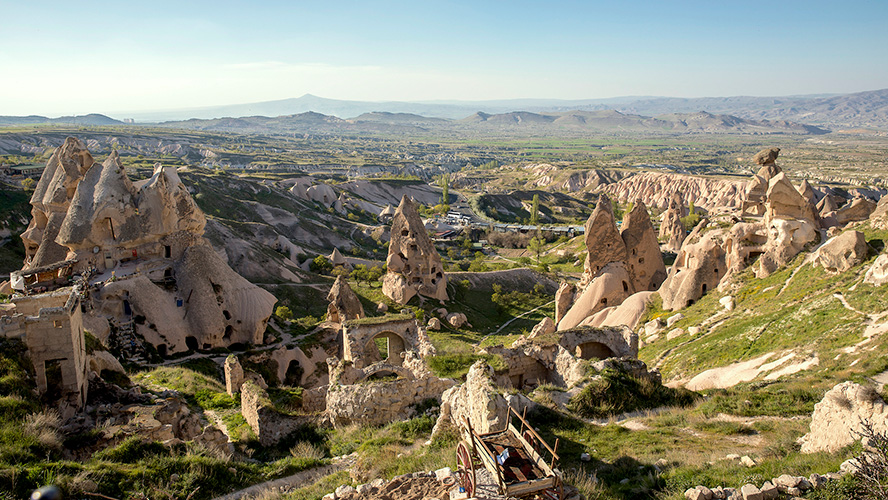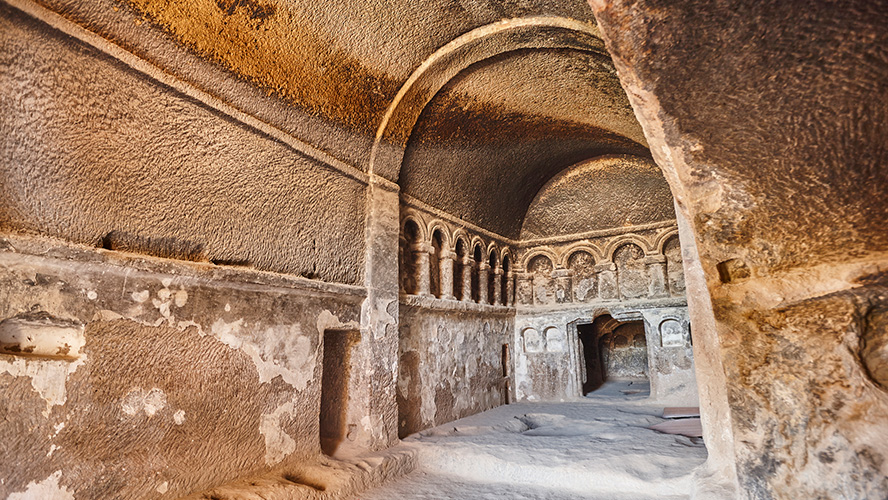The Ihlara Valley is a beautiful and spiritual place with a remarkably peaceful atmosphere. For centuries, the valley was inhabited by Byzantine monks who carved out their churches and homes from the rock. It is estimated that up to 80,000 people may have lived here at one time, but the valley was abandoned by the 11th century. Today, you can hike a hugely enjoyable trail through the valley and stop off at 60 churches along the way, admiring the frescoes they contain inside.
Surroundings and natural context
The Ihlara Valley is a canyon that is about 14 km long and rises up to a height of 120 m above the Melendiz River. It was formed by volcanic activity in the area thousands of years ago.
In fact, it is near Mount Hasan and Mount Melendiz, two of the three volcanoes in Cappadocia, and the valley has similarly impressive cliffs. Many say that it is the largest formerly inhabited canyon in the world because at one time it was home to 80,000 people.

From the riverbank, the surrounding nature is craggy but peaceful. You can choose between several hiking routes if you would like to explore the area, and each one follows the dozens of meandering curves made by the Melendiz River as it winds its way through the valley. The trails also lead to the remains of 60 rock-hewn Christian churches.
The natural location of the valley gives it a climate that is more similar to the Mediterranean than to the continental climate found in the rest of the area.
How to get there
You can travel from Ihlara to the start of the valley by car or on a tour, although there are also other entrance points along its 14-km length. The most popular entrance is about four kilometres from where the valley starts and it has an incredible 350-step stairway with incredible views that leads down to the banks of the Melendiz River.
You can also reach the valley from an entrance in the village of Ihlara, or from two other trail starting points: in Belisirma, halfway along the trail at km 7 (which has easy parking), and from Selime Monastery.
What to see during your visit
Hiking the valley route gives you the opportunity to visit dozens of Christian churches where you can admire beautiful Byzantine frescoes. Unfortunately, some of the temples are in extremely poor condition, so the most important ones are highlighted below so you can make sure to see them on your hike.
Kokar Kilise (the Church of St Andrew in Cynocephalia) is in the first part of the route. Its entrance has been partly blocked by a landslide, but you can still visit the ruins of the apse inside. It has several New Testament frescoes such as the Annunciation, the Nativity, and scenes from the Adoration of the Magi. Further frescoes include the Passion of Christ, the Last Supper, and the Crucifixion.

Another particularly eye-catching church is known as the as the Church of the Terraces; it is roughly 100 m from Kokar Kilise and also contains a funerary chamber. Its frescoes date from the archaic period and are freer and less detailed that those mentioned above.
The Church under the Tree or the Daniel Pantonassa Church, named after one of its most important paintings, is quite different to others in the valley. You enter through a ruined archway and the church is decorated with floral motifs and chequerboard patterns. Its floor plan isn’t the typical Greek cross used in most Byzantine churches, and it is particularly notable for the frescoes of Daniel in the lion’s den, and the Dormition of the Virgin, the only depiction of this scene in Cappadocia.
Hiking trails in the area
Many trails start in the valley, but the main route runs for 14 km from Ihlara to Selime along the riverbank. It is an easy route to walk and is accessible to all, so everyone can enjoy visiting the churches and admiring the views.
The valley has a similar climate to the Mediterranean, which means the trail takes you through vineyards and past pistachio plantations, one of the most important local crops. Flourishing poplars also create a habitat that is rich in fauna such as lizards and butterflies, and even eagles circle the cliffs above.
The river has 26 bends as it runs through the valley, and you may well spot herds of lambs and sheep grazing by the water, adding to the wonderful sense of peace you will enjoy on your walk.






































































